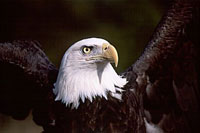
Although bald eagles can be observed year-round, Arizona is home to the greatest number of bald eagles during the winter when both resident populations and wintering/migratory populations are present. During this time, about 300 bald eagles are counted each year. Since wintering bald eagles are social, high mountain lakes, such as upper and lower Lake Mary near Flagstaff, are often occupied by dozens of bald eagles of all ages. By late February, most of these wintering bald eagles migrate north.
The breeding bald eagle population is primarily located in central Arizona along many of the state’s rivers and lakes. These breeding bald eagles remain close to their breeding areas from December through late July and provide a great opportunity for recreationists to, at a safe distance, observe bald eagles throughout their breeding cycle. As the hot summer temperatures arrive, the high mountain lakes, once again, become the best areas in the state to view bald eagles.
For viewing opportunities, visit our
Events page. Additional watchable wildlife information in Arizona can be found on
Arizona Game and Fish Department's watchable wildlife page.
If you are visiting bald eagle country, follow these simple guidelines to help ensure that our living wildlife legacy will last for generations to come:
- Enjoy bald eagles from a distance and outside any closures, especially during critical nesting times (December to June). Closure areas are posted with signs and/or buoys, and most have daily nestwatch monitors. Anyone approached by a nestwatcher and asked to cease an activity or leave a closed area should comply.
- To get a closer view, use binoculars or a spotting scope instead of approaching the bald eagle. The same applies for taking pictures. Great photos can often be taken through a telephoto lens, binoculars, or spotting scopes.
- Bald eagles protecting an active nest will let you know if you are too close. If a bald eagle is vocalizing (hear a typical call) and/or circling the area frantically, you are too close and need to leave the area quickly. Bald eagles incubating eggs or brooding small young should never be off the nest for more than 15 minutes.
- Help from anglers is especially needed. Monofilament and tackle has killed two nestlings and has been found in two-thirds of all bald eagle nests in the state. Every year, biologists remove this potentially lethal material from nests and/or entangled nestlings. Ospreys, shorebirds, waterfowl and songbirds also succumb to this litter. Do not discard any type of monofilament along rivers and lakes. If you come across discarded monofilament, remove it from the area. The monofilament can be recycled in Monofilament Recovery Bins located at many popular fishing areas or at many fishing stores. Keep your monofilament fresh; do not use old, brittle line. Make sure to use the correct test line for the fish you are trying to catch. Also, do not cut the line when an undesirable fish is caught and return it to the water with the hook and line attached.
You can help bald eagle research and recovery efforts by reporting any harassment or shooting of bald eagles. Call the Arizona Game and Fish Operation Game Thief Hotline at (800) 352-0700 or U.S. Fish and Wildlife Service Law Enforcement at (480) 967-7900.

 Although bald eagles can be observed year-round, Arizona is home to the greatest number of bald eagles during the winter when both resident populations and wintering/migratory populations are present. During this time, about 300 bald eagles are counted each year. Since wintering bald eagles are social, high mountain lakes, such as upper and lower Lake Mary near Flagstaff, are often occupied by dozens of bald eagles of all ages. By late February, most of these wintering bald eagles migrate north.
Although bald eagles can be observed year-round, Arizona is home to the greatest number of bald eagles during the winter when both resident populations and wintering/migratory populations are present. During this time, about 300 bald eagles are counted each year. Since wintering bald eagles are social, high mountain lakes, such as upper and lower Lake Mary near Flagstaff, are often occupied by dozens of bald eagles of all ages. By late February, most of these wintering bald eagles migrate north.